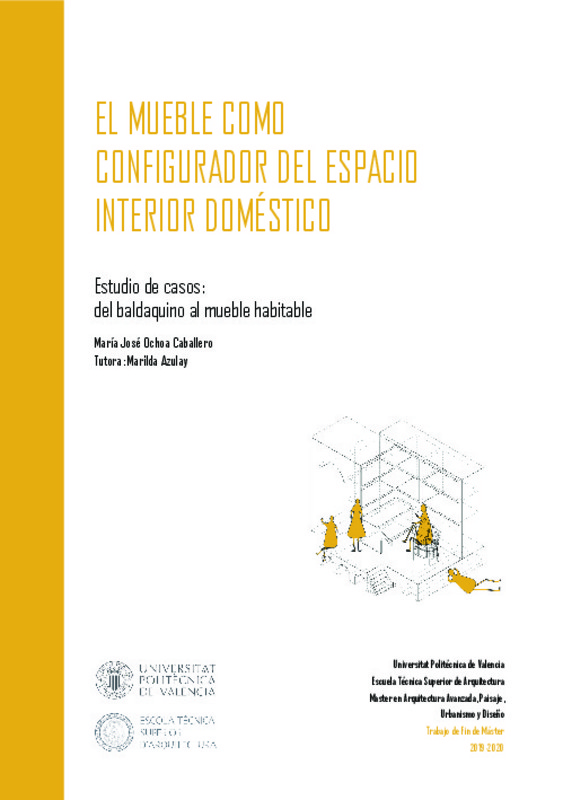JavaScript is disabled for your browser. Some features of this site may not work without it.
Buscar en RiuNet
Listar
Mi cuenta
Estadísticas
Ayuda RiuNet
Admin. UPV
El mueble como configurador del espacio interior domestico. Estudio de casos: del baldaquino al mueble habitable
Mostrar el registro sencillo del ítem
Ficheros en el ítem
| dc.contributor.advisor | Azulay Tapiero, Marilda
|
es_ES |
| dc.contributor.author | Ochoa Caballero, María José
|
es_ES |
| dc.date.accessioned | 2021-01-25T09:40:56Z | |
| dc.date.available | 2021-01-25T09:40:56Z | |
| dc.date.created | 2020-12-10 | |
| dc.date.issued | 2021-01-25 | es_ES |
| dc.identifier.uri | http://hdl.handle.net/10251/159780 | |
| dc.description.abstract | [EN] Furniture has a fundamental function in the arrangement and definition of living spaces. For example, the Baldachin of the Basilica of Saint Peter in Rome (1623- 1634) and the Saint Jerome Desk in the painting by Antonello da Messina (1474-1475) are two elements we have defined as ¿architectural furniture¿ that have managed to domesticate a space by introducing a more human scale in a large nave in two monumental scale buildings. These elements have made it possible to incorporate a new use, reestablish a hierarchy reinforce a meaning, while respecting the value of the architecture that houses them. In a similar way, in the domestic line of work, we can find furniture that, due to its arrangement, dimension, scale, location and function, shapes domestic interiors as a reflection of the ways of living and ways of thinking about space. This research looks into the mechanisms used in a collection of cases of home renovations to study those strategies that allow us to design spaces through fixed, autonomous, or habitable pieces of furniture which can condition the space and affect categorically, formally, and functionally how we live. ¿The city and the territory in which we will live in the next few years is already built¿ (Secchi, 1984), so the most sensible thing to do as architects and from the perspective of this work, as a response to the housing problems in the consolidated city should be to rehabilitate. Rehabilitating housing from furniture is not only a functional and economic possibility but also an architectural proposal. The intervention can be based on strategies that do not impose pre-established schemes of regeneration of spaces and have the potential to introduce new ways of living that, based on architectures of the past can see into the future. | es_ES |
| dc.description.abstract | [ES] El mobiliario tiene una capacidad fundamental en la configuración y definición de espacios habitables. En el ámbito monumental vemos que dos elementos que definimos como ¿muebles arquitectónicos, el Baldaquino de la Basílica de San Pedro de Roma (1623-1634) y el Escritorio de San Jerónimo en la pintura de Antonello da Messina (1474-1475), han logrado domesticar un espacio introduciendo la escala humana en una nave de grandes dimensiones. A su vez, estos elementos, desde diferentes objetivos y mecanismos, han posibilitado un uso, establecer una jerarquía y reforzar un significado respetando la arquitectura que los acoge. De manera análoga, en el ámbito doméstico, encontramos muebles que, por su disposición, dimensión, escala, ubicación y función, configuran el espacio interior como reflejo de las formas de habitar y de pensar el espacio. Esta investigación se centra en el estudio de aquellas estrategias que, con el mueble como elemento adosado, autónomo o habitable, da forma al espacio a la vez que afecta categórica, formal y funcionalmente al habitar. Para ello se estudia los distintos mecanismos utilizados, en una recopilación de casos de rehabilitaciones de viviendas. La ciudad y el territorio en el que viviremos en los próximos años ya está construido (Secchi, 1984); lo más sensato desde nuestro quehacer como arquitectos y desde la propuesta de este trabajo como una respuesta a la problemática de vivienda en la ciudad consolidada debería ser rehabilitar; y rehabilitar la vivienda desde el mobiliario es una posibilidad no solo funcional y económica sino también una propuesta arquitectónica, ya que la intervención se puede basar en estrategias que no impongan esquemas preestablecidos de regeneración de espacios, sino que posean el potencial para plantear nuevos modos de habitar que, teniendo de base arquitecturas del pasado puedan ver al futuro. | es_ES |
| dc.format.extent | 222 | es_ES |
| dc.language | Español | es_ES |
| dc.publisher | Universitat Politècnica de València | es_ES |
| dc.rights | Reconocimiento - No comercial (by-nc) | es_ES |
| dc.subject | Habitable furniture | es_ES |
| dc.subject | Architectural furniture | es_ES |
| dc.subject | Interior Design | es_ES |
| dc.subject | Muebles | es_ES |
| dc.subject | Muebles habitables | es_ES |
| dc.subject | Muebles arquitectónicos | es_ES |
| dc.subject | Muebles compactos | es_ES |
| dc.subject | Espacios habitables | es_ES |
| dc.subject | Espacios domésticos | es_ES |
| dc.subject | Interiores domésticos | es_ES |
| dc.subject | Living spaces | es_ES |
| dc.subject | Domestic spaces | es_ES |
| dc.subject.classification | PROYECTOS ARQUITECTONICOS | es_ES |
| dc.subject.other | Máster Universitario en Arquitectura Avanzada, Paisaje, Urbanismo y Diseño-Màster Universitari en Arquitectura Avançada, Paisatge, Urbanisme i Disseny | es_ES |
| dc.title | El mueble como configurador del espacio interior domestico. Estudio de casos: del baldaquino al mueble habitable | es_ES |
| dc.type | Tesis de máster | es_ES |
| dc.rights.accessRights | Abierto | es_ES |
| dc.description.bibliographicCitation | Ochoa Caballero, MJ. (2020). El mueble como configurador del espacio interior domestico. Estudio de casos: del baldaquino al mueble habitable. Universitat Politècnica de València. http://hdl.handle.net/10251/159780 | es_ES |
| dc.description.accrualMethod | TFGM | es_ES |
| dc.relation.pasarela | TFGM\122701 | es_ES |
Este ítem aparece en la(s) siguiente(s) colección(ones)
-
ETSA - Trabajos académicos [4687]
Escuela Técnica Superior de Arquitectura








